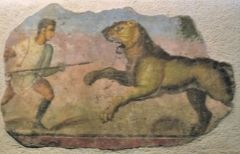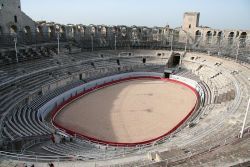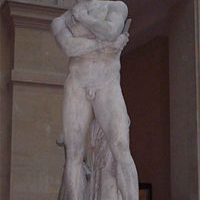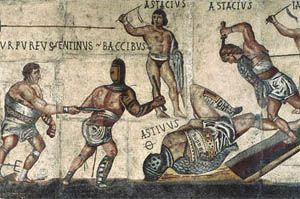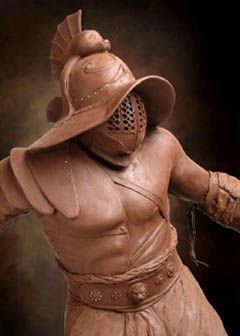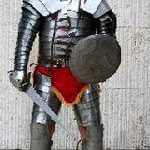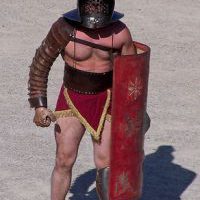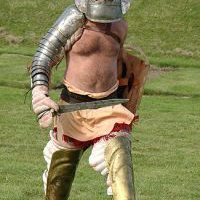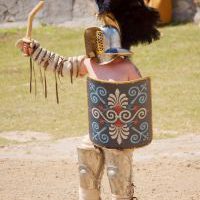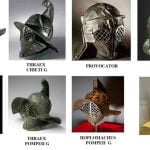Chapters
Gladiator (gladiatores) was a wrestler fighting in the arena or amphitheatre. His name came from the Roman sword, gladius. Gladiator fights were called munus (pl. munera), which meant “sacrifice for the dead”.
Many people today think that gladiators’ fights in the arenas always ended with the death of one of the fighters. However, this is not true. It is known that gladiators had excellent medical care, and their lives were more valuable than those of a single citizen. However, it can not be concealed that the “slaves of the arena” died at a relatively young age. The average age was 30 years and it was rare for a gladiator to live longer. It should be emphasized, however, that the commonly existing idea of a gladiator’s certain death is a myth.
Excellent training and incredible courage of gladiators were repeatedly used by the emperors who incorporated them into the army, as it was during the “Year of the Four Emperors” in 69 CE. At that time, when there were no recruits, two legions of slaves were set up, among whom there were probably many gladiators. They were also recruited to serve as the rulers’ or citizen’s guards.
Interestingly, today’s name “arena” is derived from the Latin word harena, which meant absorbent sand, which was scattered on the ground at the place of gladiators’ fights and aimed at absorbing the blood of the fighters.
History of gladiators’ fights
Gladiator fights at funerals
The custom of gladiators’ battles comes from the Etruscan tradition of worshipping the dead through struggle, instead of making human sacrifices. In Rome, this kind of fighting appeared for the first time probably in the year 264 BCE. At the time, at the funeral of senator Junius Brutus Pera taking place at the Forum Boarium, six warriors (three clashes) fought to commemorate the late senator. The organizer of the event was Decimus Junius Brutus, who honoured his father in this way. Among the gladiators, there were also his two sons. After this event, gladiatorial fights became one of the most popular Roman pastimes.
As Rome was expanding and many slaves came to Italy, gladiatorial struggles were organized on a big scale. At the end of the 3rd century BCE at the aristocrats’ funerals, fought dozens of war prisoners. With time, munera became more an “advertisement” for their organizers than a real tribute to the deceased. While at first, only the family used to watch the fight in silence, later many people began to come and watch, as interested in the bloody spectacle and loudly “cheering” the gladiators. Gradually, the religious rite turned into a source of entertainment for the people. In 183 BCE the family of the deceased Publius Licinius Crassus organized munera, which took part of 200 prisoners. The fights lasted for a few days and brought crowds of spectators. From then on, gladiatorial battles became Olympic games – a spectacle as popular as chariot races. Scipio Africanus organized a huge munera out of Rome in 206 BCE – after conquering the New Carthage, several hundred captives were forced to fight against each other.
Arena fights
With time, the organization of gladiatorial struggles became a tool in the hands of politicians, who gained the favour of the people this way. With time, the organization of gladiatorial fights became a tool in the hands of politicians, who in this way influenced politically or won the favour of the people. At the end of the 2nd century BCE, the first gladiatorial competition was held, which was not to pay tribute to the deceased, but to raise the spirits of citizens, when Italy was threatened with a Teutons’ invasion. The event was organized by the incumbent consuls: Rutilius and Manlius, and since then many politicians saw an opportunity to gain popularity among the people in this way. From then on, munera was not organized according to needs, but rather took the form of regular shows.
Lots of money was spent, and loans were even made to organize the most sumptuous games that would be memorable and ensure a high position. The organization of spectacular gladiatorial struggles was even demanded from people elected to be aediles. During the munera funded by Pompey in 55 BCE fought not only prisoners but also exotic animals – lions, tigers, leopards, elephants. Numerous schools were established, where slaves were being prepared for duels in the arena. An increasing number of gladiators were associated with the risk of uprisings – the largest and the most dangerous, under the leadership of Spartacus, took place in the years 73 – 71 BCE. After the initial successes, the rebels were beaten by Crassus, and thousands of captured alive were crucified along Via Appia. The ruthlessness with which it was suppressed caused that later such rebellions were less common.
At the end of the Republic, the popularity of the munera increased steadily and was organized during most of the holidays. Some of the best gladiators became widely known, as today’s outstanding athletes. During this rough period, when riots were frequent, many rich Romans bought up gladiators famous for their skills and employed them as private security guards.
During the Empire, the games were even more spectacular. It was organized by the emperor, and the distribution of grain for free was the best method of satisfying the poor (the famous slogan “bread and games”). The number of holidays, on the occasion of which the munera took place, increased. During the reign of Augustus it was 66 days a year, then more than one hundred, and in the 4th century – 175. If you add to this fights organized by the emperor and various rich people without a special occasion, then it can be said that in imperial Rome there was almost no day without gladiatorial fights. It was similar in the provinces – Roman amphitheatres, where prisoners fought, are still standing in many European cities.
Starting from the half of the 1st century CE munera became more and more macabre. With the madmen such as Nero or Caligula in the arenas happened things disgusting for many Romans. In addition to ordinary fights of armed gladiators with equal chances, terrible executions were carried out in front of the audience – the condemned were burned alive, crucified or thrown to the lions to be devoured. Persecuted Christians usually ended up in the arenas of Roman amphitheatres. In turn, emperor Domitian, known for his cruelty and black humour, liked women and dwarves in battles. All boundaries crossed the insane Commodus, personally fighting in the arena. The 2nd and 3rd century CE was a period of the greatest development of the munera – huge games with thousands of gladiators lasted in Rome for months. Trajan in 107 CE organized the largest Games in history – lasting 123 days, and 10 000 gladiators fought in them.
End of gladiatorial fights
In the 4th century CE Christianity became more significant for the Romans. This religion could not agree to the bloody games, which, however, still had great popularity. For the first time, gladiatorial battles were forbidden by Constantine the Great in 326 CE under the pressure of the Church. In reality, however, in Rome and Italy, as well as in other provinces, they usually continued.
Another edict from 357 CE forbade the participation of soldiers and Roman officials in the battles. In 397 CE it was forbidden to recruit gladiators as bodyguards, which was a very popular practice during civil wars. In 399 CE it was decided to shut down most of the gladiatorial schools. The last official battles in Rome took place in 404 CE for Honorius, in fact, they were organized until 440 CE.
How much was spent on munera?
Polybius, who lived in the 2nd century BCE, states that organizing the games did not cost less than 30 talents, or 750,000 sesterces1. In 186 BCE Hunting for wild animals was organized by Marcus Fulwius Nobilior, who, thanks to the Senate, had to limit his venatio to 80,000 sesterces.
Plutarch reports2 that Gnaeus Pompey became famous for hosting large-scale games involving wild animals. In 55 BCE when he became a consul, he started building a theatre, where he staged mimic competitions, music competitions and fights with wild animals, including elephants. According to Plutarch, 500 lions were also to be killed there. According to the information from the Edict of Diocletian of 301 CE, a first-class lion could cost a maximum of 150,000 denarii or 600,000 sesterces. It follows that 500 lions in total cost, according to the value of money at the beginning of the 4th century CE, 300 million sesterces. Of course, prices from the 1st century BCE, and the 4th century CE are not identical, as money has been losing its value over the centuries and inflation has progressed. However, this gives some idea of how much money was involved in organizing the games and how much money politicians could have borrowed.
Senatus Consultum de Pretiis Gladiatorum Minuendis
At the end of the 2nd century CE, during the rule of Marcus Aurelius, a special decree was issued Senatus Consultum de Pretiis Gladiatorum Minuendis, which regulated munera and he divided them into categories.
The following classes were distinguished, among which the maximum prices for a given gladiator quality were also given:
- Class IV: the cost of munera was between 30 and 60 thousand sesterces;
- first-class gladiator – maximum price 5000 sesterces;
- second quality gladiator – maximum price 4000 sesterces;
- third quality gladiator – maximum price 3000 sesterces.
- Class III: cost of munera was between 60 and 100 thousand sesterces;
- first-class gladiator – maximum price 8000 sesterces;
- second quality gladiator – maximum price 6000 sesterces;
- third quality gladiator – maximum price 5000 sesterces.
- Class II: the cost of munera was between 100 and 150 thousand sesterces;
- first-class gladiator – maximum price 12,000 sesterces;
- second quality gladiator – maximum price 10,000 sesterces;
- third quality gladiator – maximum price 8000 sesterces.
- fourth quality gladiator – maximum price 6000 sesterces.
- fifth quality gladiator – maximum price 5000 sesterces.
- Class I: cost of munera was between 150,000 and 200,000 sesterces.
- first-class gladiator – maximum price 15,000 sesterces;
- second quality gladiator – maximum price 12,000 sesterces;
- third quality gladiator – maximum price 9000 sesterces.
- fourth quality gladiator – maximum price 7000 sesterces.
- fifth quality gladiator – maximum price 6000 sesterces.
As stated in the edict, within each munera type, at least half of the gladiators had to be those warriors who were not fighting individually, but in a group (gregarii).
Gladiators
Gladiators could be:
- a free man (eg a soldier, a resident of Rome) after signing an appropriate “contract”;
- a criminal (for murder, mutilation, robbery, arson or lese – majesty);
- a slave;
- a prisoner of war.
Gladiators were usually prisoners of war, mainly from the Thracians, Gauls and Germans, but criminals also went to the gladiatorial school. Every strong man who had any skill in using the weapon could become a gladiator. However, if free volunteers could at any time resign from cladding in the gladiatorial school and return home, the convicts did not have that choice. It is worth noting that women were also fighting but on a much smaller scale. Women’s fights grew in great popularity until their performances were banned by the emperor Septimius Severus, c. 200 CE. Apparently, Domitian particularly liked to watch struggles between women.
It should be emphasized that gladiators never dressed up as legionaries, nor did their wear full armour. This was due to the fact that the gladiator was lower in rank and respect than a professional soldier in the Roman army.
Spartacus in the last battle hit the legion as he wanted to kill Crassus. Probably his body was dismembered with gladius because the corpse could not be found after the battle. There were rumours, however, that he managed to escape from the battlefield and settle in Gaul.
The level of gladiator training was very high. At school, they were punished even for such things as squinting when the sword was waving right in front of their nose. Peaceful training ensured strict discipline and cruel punishments for the disobedient. Some, however, did not cope with such conditions. A mass murder of 29 Saxon prisoners who preferred to commit suicide rather than fight against each other in the arena. However, the gladiators were provided with food and medical care at school, which exceeded what the average free Roman could expect. In addition, every owner (lanista, from the Etruscan “butcher”) had to provide his ward with all the comforts, lovers and equipment. After the fight, the gladiator received the appropriate amount of money that could be used for entertainment and other activities.
The gladiators were garrisoned in ludi, and trained under the supervision of a teacher. The team of gladiators from one school created the so-called familia gladiatoria and was rented or resold to an official (editor) who organized the fight. The most famous gladiator school was in Capua, where, among others, trained Spartacus in the school of Lentulus Batiatus. Also, schools in Rome and Ravenna are worth mentioning. Gladiator’s career was very much appreciated in ancient Rome. Women loved them for their courage and bravery, and society adored their way of fighting. The sympathy of the public, which increased the slave’s chance of liberation, was particularly valuable. The gladiator might have obtained freedom on the basis of the owner’s or the emperor’s decision. It was also possible to redeem oneself from slavery. Usually, liberation came after many years of fighting in the arena. The gladiator then received a wooden sword (rudis), symbolizing the end of the gladiator’s life and the beginning of a free life. However, he had the right to continue fighting in the arena or to train new gladiators.
On the social ladder, gladiators were on par with slaves, beggars and criminals. They did not have any rights, and the owners were the only ones who decided about their lives. The dead were not buried in the arena unless the owner, family or one of the devotees demanded it. Gladiators could set up families and in exceptional cases, they were allowed to live outside the barracks.
Gladiators initially fought in squares or forums in various cities of the state. In the period of the late republic, buildings designed specifically for the fight of gladiators – amphitheatres began to be built. Of course, the most famous and at the same time the largest was the Flavian Amphitheater, which could seat 50,000 spectators.
Gladiator’s life
Gladiator fights spread in Rome at the end of the republic and came there from Campania. Initially, they were a spectacle organized by private people, and from the end of the 2nd century BCE officially included in the program of the games. Gladiators were recruited from among prisoners of war, convicts and slaves, who then underwent appropriate training.
Man for example captured during the battle was taken prisoner and became a house servant or labourer in a quarry. Being a servant, he did not have much chance of getting into the arena, as he was usually not good enough for it. On the other hand, strong and resilient men who could withstand hard work were being taken to the quarries. From time to time, a merchant (owner of gladiators) appeared in the quarries, bought selected slaves and then put them in the arena.
In ancient Rome, there were special schools for the gladiators in which slaves were trained and cared for. Each of them received medical care, a separate cell and food (mainly beans, barley). They learned how to use the weapon properly, according to their specialization, but also to accept the dignity of death. Every day, they trained blows on a 180 cm high palus, a wooden training pole. At the end of a few months of training, there was a test, which was to judge whether the gladiator is ready to fight in the arena. To this end, he fought with wooden swords on a platform with an armoured rival. If the slave won, he became a gladiator and could represent his master in prestigious battles. If the gladiator had been lucky, he could have met a novice, but if he had not been so fortunate, his future would have been uncertain.
Gladiator fights were fought between the schools from which they came. Before the fight, they armed themselves with the equipment they used the most. It should be emphasized again that the death of any gladiator rarely occurred. Unless we talk about the games organized during Titus‘ (the son of Vespasian) reign. Titus, after the construction of the Colosseum, organized great games in honour of his father. At that time, no one was spared in the arena, of course, to the delight of the viewers.
Gladiators enjoyed enormous popularity and, therefore, success among women. There were even situations where the sweat of Roman gladiators was sold in vials as an aphrodisiac!
The death of the protégé was a huge financial burden for the owner. He had to be replaced by a new, well-trained warrior, which unfortunately cost a fortune. Therefore, the gladiator’s life was in the hands of the most outstanding doctors. It is worth mentioning Galen of Pergamon, later a personal physician of Marcus Aurelius. He worked in one of the gladiatorial schools in Asia Minor from the first half of the 2nd century. It is he who is credited with healing Commodus from the mysterious epidemic brought to Rome from the East by his uncle Lucius Verus.
According to the latest research, it was found that gladiators ate mainly barley, chickpeas, peas, beans and lentils. Legumes were also a basic component of the diet of Roman soldiers, because, like today’s military pea soup, it is an easy-to-obtain food, a satisfying and cheap meal.
Before entering the arena, the gladiators were swearing (autocratusa) that they would not be spared in the fight. It is also a myth that before the fight, the gladiator paraded in front of the audience with his hand raised in a welcome gesture, reciting the quote “Ave Imperator, morituri te salutant!” (“Hail, Emperor, those who are about to die salute you”), because this is confirmed by only one message from Suetonius. On the other hand, somehow gladiators certainly greeted the crowds and the organizer of the games. Fights did not last longer than a few minutes, though there were sometimes many hours of duels. Duels took place mostly in the afternoon. The fight could not be avoided because passive gladiators were whipped or pricked with burning hot rods.
Among the fighters there was a referee (summa rudis) who supervised the fight and could stop it if any of the gladiators were seriously injured or used illegal “plays”, encouraging gladiators to fight bolder or give the decision to win to the sponsor of the games (editor). The judges wore long sticks/rods (rudes) to indicate illegal movements or to urge fighters. They were dressed in white tunics with maroon trim (clavi). Additionally, there could be a second referee secunda rudis in the arena.
It is believed that the struggles between the gladiators were carried out according to certain rules. We do not know them much, but some are clear. For example, the Referee could announce a duel (diludium) if the shield or piece of armour broke or fell. Then the armoured man could repair the damage. Summa rudis also had responsibilities. He gave loud advice and instructions regarding attack or defence. If the gladiator did not play a straight bat or avoided the fight, the fight could have been stopped and the gladiator – whipped.
A defeated opponent could ask for mercy by raising a finger, to which the crowd observing the fight responded with their thumbs up (which meant giving life) or directing it down (death) – so-called pollice verso or verso pollice (literally “with a turned thumb”). However, this is a debatable matter, some scientists believe that they were pointing their thumbs down to give life, and to their throat when they wanted the gladiator to die. There is also another theory saying that the finger-pointing up after the gladiator’s defeat most likely did not mean giving life, but rather was a signal to kill him quickly as evidence of mercy for a brave attitude. In turn, the thumb was directed towards the neck, which meant death with a sword in the neck, or actually in the back, to damage the cervical vertebrae and in this way cause the warrior’s quick death.
According to the current state of research, the hypothesis is most likely that a thumb pressed to the index finger (a hand curled into a fist) or a thumb hidden in a fist meant a request for grace, while a thumb protruding above a folded fist (the direction does not seem to matter) or an extended hand meant a deadly blow skillfully and cowardly he could not count on mercy. Enraged people shouted: “pierce him!” (lugula). At that time it was expected that the defeated, kneeling, would raise his head and wait for death in cold blood, as he was trained to. The winner made the blow with both hands, thrusting the sword in the back in the area of the left shoulder or in the heart, between the left collarbone and the neck. When the defeated could not continue fighting, he performed the following ritual: he threw the shield and the sword, kneeled on his knees, putting his hands on his back. In this position, he waited for mercy. Another gesture was throwing the weapon and kneeling before the winner with his head bowed, embracing his leg.
From the audience, you could also hear the words: Mitte! (“Save it!”) Or Iugula!(“Kill!”).
If any of the fighters eventually died, two men entered the arena. One represented Mercury, the other one was Charon. In order to check whether the gladiator was really dead, the first one hit his body with a hammer, and the second one touched it with a red-hot iron. The body was then pulled out of the arena using sharp hooks to the dospoliarium, where it was stripped of armour and clothing. The corpse was thrown onto the wagon and together with other killed people were taken outside the city to mass graves. Sometimes other gladiators bought the body of the fallen and provided him with a funeral.
The winner received a palm, later also cash prizes, release from further participation in the battles, and even freedom. The fights ended usually in the evening. Gladiators who won that day received palm branches and cash prizes. The organizer received a kind of report – a list of gladiators with markings by their names – V (vicit) meant victory, P (perrit) death, and M (missus) meant defeat and pardon.
Occasionally there were also draws when both gladiators were unable to continue fighting due to wounds; such a result was accepted only when the commitment of both warriors to the fight was evident.
In a situation where both gladiators did not want to fight or there was a kind of rebellion, soldiers entered the arena or archers were used.
In a situation where the defeated was unable to continue the fight or wanted to give up, he had to throw away his weapons, kneel on both knees and fold his hands behind his back. Thus he awaited a decision as to the mercy of the organizer of the Games or the crowd. If the loser was sentenced to death, the blow was delivered by the opponent with a sword, with both hands – either near the left shoulder blade, or aiming between the left collarbone and the neck; thus the blade was to pierce the heart.
The weaker gladiators usually became the first to fight. They were displayed in pairs of several from each school. Then, exotic animals were used that fought between themselves and unarmed or armed gladiators or with gladiators (bestiarii) – these were the so-called venationes. Especially desirable were huge Germanic aurochs, bears, African tigers, lions and panthers, which were imported from the most distant parts of the Empire. In the end, there was a fight of the day, in which two best gladiators from two different schools met. Some gladiators were promoted, giving them easy-to-beat opponents, so-called “hares”. In this way, also, fighting was set up.
Gladiators’ performances were also of a different nature. From the middle of the 1st century BCE, the games often ended the fights of the andabates, kind of gladiators, scrabbling in helmets with a visor without holes for eyes. It gave their performances a comic character. Over time, gladiators were also used to entertain guests in private estates during feasts.
Before the proper fights of gladiators, the so-called paegiarii had the task of warming up the crowds before the battles of the evening. The warriors were armed with wooden swords (rudis), and the body protected the imposed bands. Their fighting was accompanied by dulcimer, trumpet and so-called hydraulis – water organs. Paegiarii were extremely popular at the Olympics in the Colosseum during the reign of Commodus. These Gladiators did not die in the arenas.
During the breaks between the fights proper in the arena, paegniarius appeared, who was a clown dressed in parodies of gladiatorial armour. Often their shields were decorated with humorous or erotic patterns, while the armour was full of bizarre decorations. Their task was to entertain the crowd during breaks or during the gladiators’ preparation. It seems that most of them parodied the fights between different types of gladiators and made all sorts of clowning. They also made harsh allusions to the current events in Rome and performed some scenes based on mythical events, such as the fight of cupids and satires.
Gladiators during their short lives could count on the professional medical care of those who had great experience and knowledge after years of education. In addition, they were entitled to masseurs (unctor), often slaves who took care of the condition of the body. In their free time, warriors had the chance to go to terms with or satisfy their sexual desire. They did not have to look specifically for their chosen ones, because many wealthy women paid a lot, just to be able to spend an amazing night with a great gladiator. In Rome, among women, there was the ideal of a strong and courageous man who the gladiators perfectly impersonated.
More wealthy gladiators could even afford an epitaph to commemorate their lives. Forged in stone, a short inscription could not, of course, skip the balance of accomplishments: the number of fights fought or the laurels won. On the tombstone of a certain Urbicus who died in his thirteenth fight, there was engraved a piece of advice for his inexperienced colleagues: “I advise you to kill, those whom you have knocked down”.
The patron of gladiators was Hercules, the mythical strongman. Interestingly, over time gladiators began to form associations and clubs associating people with similar interests.
Gladiators’ fights were extremely popular entertainment among Romans and any attempts to prohibit the organization of fights led to social unrest. It is worth mentioning Julius Caesar, who instead of spending time together with the people watching fights, devoted himself to studying laws and protocols, which negatively affected his popularity. Some of the rulers were also reluctant towards the fights: Claudius and Marcus Aurelius, who, however, did not prohibit the organization of the games, afraid of the reaction of the crowd.
For comparison, huge fans of gladiatorial fights were, for example: Caligula, Nero and Commodus, where the latter loved to stand in the arena. Commodus fought in the arena with the gladiators, whom he often killed in a tricky way. There is a message about the duel of the emperor with the gladiator Sceva, who detected the emperor’s scheme. After this fact, the scared emperor did not take up the fight but dismissed the powerful gladiator.
Fights, but not a slaughter
The cost of training a gladiator was very high. Training gladiator costs even tens of thousands of sesterces. In Institutes3 the Roman lawyer Gaius reports that when the owner of the gladiator loaned him for a fight in munera he received 20 denarii (80 sestertii) for the return of his alive gladiator from the arena, and a thousand denarii for the disabled or the dead. As you can see, the goal was for gladiators to give an interesting fight, not a bloody one. Hardly any school would allow itself carnage in which dozens of gladiators would lose their lives.
Moreover, it should be emphasized that a doctor was often admitted to the arena so that he could quickly dress the wounds. The doctor then assessed which gladiator was fit for the fight, and which was crippled after his injuries.
Of course, gladiators also died. Until today, many gladiators’ cemeteries have been found. But it certainly is not so bloody as is now presented. Many gladiators were given freedom after winning dozens of fights, and many Romans and Romans saw fights as an opportunity to make a good career and earn money.
What did gladiators eat?
Subsequent fights and constant effort required the gladiator’s body to receive the right amount of food with the right nutritional values. We know about what ancient gladiators ate thanks to discoveries from Turkey and ancient records.
Lots of carbohydrates
In 1993, in Ephesus (the western part of Turkey), the former capital of the Roman province of Asia, an ancient burial ground was found, where, according to researchers, gladiators were buried. A total of over 60 people were buried in the cemetery, of which 22 gladiators and 31 other people buried on the spot, not fighting in the arena, were examined. Researchers conducted detailed studies of the bones and skulls of the buried bodies for comparison purposes4. The conclusions were surprising: the gladiatorial diet was, in today’s view, very vegetarian and high in carbohydrates; or rather low in protein. After the isotope analysis was performed, it turned out that the gladiators, compared to the rest of the city’s inhabitants, ate much more vegetables and less meat. Hence the colloquial term for gladiators – hordearii used by Pliny the Elder, meaning “barley-eaters”5.
Moreover, gladiators were not perfectly muscled men, with impeccable figures in our opinion, but rather had significant amounts of fat. We also have sources describing the catering of gladiators. It is, for example, Galen, a Roman medic, who in 159-161 CE he worked in a medical school that looked after the health of gladiators in Pergamon (now western Turkey). Galen mentions that gladiators ate mainly barley (either in the form of a pudding or with water as a drink) and legumes (such as broad bean soup). Another type of meal was broad beans mash (vicia faba) mixed with peeled barley6. Dried fruit was also eaten. Food was easy to prepare and cheap. Carbohydrates allowed the gladiators to fill their stomachs and provide the necessary energy for exercise and fighting in the arena.
Scientists believe that such a diet was aimed at acquiring significant amounts of subcutaneous fat. It was extremely helpful in the arena because it protected the most important parts of the body, such as ligaments, nerves, and blood vessels from cutting. It guaranteed a better spectacle for the masses, as the gladiators were injured, you could see cut and bloody bodies, and yet they were still fighting in the arena.
Interestingly enough, Cicero in his third Philippics aimed at Mark Antony, compares his body to a gladiator, suggesting a bulky body and diminishing his status.
Coming back to Galen – we know that as medicus he was able to save two gladiators when as many as 60 of them died during his predecessor. Working at the gladiators’ school was a huge challenge for Galen, but also an important lesson that taught him tops. His vast knowledge of anatomy enabled him to become the personal physician of Emperor Marcus Aurelius.
Special drink
However, a diet based on grain products (the so-called sagina or gladiatoriam saginam) caused significant calcium deficiencies. To maintain strong bones, a special decoction of charred wood (or plants) and bone ash, which was very rich in calcium, was drunk. In this way, the bones could heal faster and were much more durable. Compared to the bones of other inhabitants of Ephesus, gladiators had really strong bones. So it was an early form of supplementation.
Shared feast
In the evening before the fight, the gladiators feasted together (cena libera) as part of their family, which on the one hand was to be a form of relaxation and a possible farewell to the world in case of failure. At that time, the menu was probably more sophisticated and supplemented with meat (venison, pork, fish). Interestingly, Plutarch mentions that the food was good, however, gladiators were not very interested in it. Perhaps it was due to the stress before the fight.
Types of Roman gladiators
Gladiator | Description |
Andabata (pl. andabatae) | Dressed in heavy chain mail and a helmet with a visor without holes for eyes. |
Bestiarius | Equipped only with a dagger or a spear. He fought with wild animals (in fights called venatio), often suffering death. |
Caterviarii | He fought in groups. |
Crupellarius (pl. Crupellarii) | A heavily armoured gladiator whose fighting style came from Gaul. A typical crupellarius was armoured in lorica segmentata, carried a manica in his hands and wielded a gladius and a scutum (sometimes a smaller shield). His helmet was in the shape of a punched metal basket, with small holes for eyes and mouth – similar to a medieval cup-shaped helmet. The large weight of the armour meant that the crupellarii could only be very strong men. In the fight, he took the defensive side, taking counter-attacks and awaiting his opponents’ moment of weakness. The Roman historian, Tacitus, mentions crupellarii in the first century CE. During the reign of Tiberius, an uprising of Sacrovir and Florus in Gaul in 21 CE took place, in which the armed rebels were dressed as later Roman gladiators. |
Dimachaerus (pl. Dimarchaeri) | He fought without a helmet, using two daggers (swords). We know little about this category. |
Eques (pl. Equites) | He fought horseback. Equipped with a sword, spear and a round small shield (worn in the left hand). He wore sleeveless tunics and a wide-coloured belt. His Shins and right arm were protected by quilted armour. The helmet was constructed to protect the neck of the rider; the face was protected by a visor. The spear was about 2 meters long and ended with a broad, leaf-shaped tip. The sword was usually gladius (a standard weapon of the Roman infantry). Their armour was based on a Roman ride from around 100 BCE. Equites usually went first into the arena. They rode grey horses (these were preferred). At some stage of the fight, the riders got off the horses and fought on foot. The reason for getting off the horse’s back is not clear. It seems that they did it only when they broke the spear. Most of them ended up on foot. |
Essedar | He fought on chariots pulled by horses (essedum). |
Gallus (Gal) | It was a heavily armed gladiator, originally a prisoner of war from the Celtic tribes. He wore a round or crest helmet, a long or oval shield and was armed with a sword and a dagger. His right hand was protected by the sleeve. He had no breast protection and did not wear greaves. |
Hoplomachus | He performed in an armour based on one of the Greek hoplites. He was shielded by a helmet decorated with a great comb and feathers, metal greaves (applied to quilted protectors) and leather and woollen covers. It was equipped with a spear and a small round shield (it was much smaller than the hoplites’ – it was about 45 cm in diameter). The shield was a thick and heavy bronze plate that could be a weapon itself. His spear, 1.8 meters long, gave him a large range. Undoubtedly, the light armour allowed the gladiator to make quick moves. In a situation when the spear broke, hoplomachus drew a short dagger. The combination of a dagger and a long spear was typical for the Greek hoplites of the 1st century BCE. Hoplomachus usually fought against a murmillo or a thraex. |
Laquerius (laquearius, laqueator) | He used a loop-like rope similar to a lasso. It could have been a specialized form of the retiarius. We know little about this category. |
Murmillo (myrmillo; pl. Murmilloni) | Domitian’s favourite kind of gladiator. He replaced the Samnite, who fell out of favour in 30 CE. Equipped with a shield, a sword, an elongated shield, a helmet with a wide flat roundabout, and a large metal crest on top – a mormylos – like fish head (called Cassis Crista). A ponytail of horsehair was sometimes attached to the helmet. Some of the gladiators adorned helmets with tin or gold scales – in the sun, the armour made an interesting impression on the viewers. His armour was also ocrea (shin protector made mostly of gold or silver) and fasciae (thick padding under the protectors to prevent bruises and abrasions.) Murmillo had a large rectangular shield similar to the legionaries’ scutum, measuring over a meter and about 60 cm wide It was made of glued layers of wood, pressed in a form that gave it a semicircular shape. The edges and the centre were reinforced with bronze, and the upper was covered with leather, and painted in colourful patterns. The left arm was protected by a metal armlet, which was applied to a quilted fabric protector. the protector also covered the other hand (at the wrist), in which the warrior wielded the sword. The hand shielded the sword, the total weight of the murmillo was about 18 kilograms, while the shield itself was about 8 kg. During the fight, the warrior was facing the opponent sideways, pointing towards the left side of the body. He was slightly huddled, thanks to which he could cover his whole body with an opponent’s punch (from the visor to the greaves). Murmillo most often fought with a thraex or hoplomachus, i.e. with gladiators who were less heavily armed. |
Provocator | This type of gladiator appeared only in the 1st century BCE and enjoyed great popularity. His weaponry differed depending on the type of fight. He usually wore a shield similar to a legionary’s shield, short greaves, and a quilted handguard, in which he held a short sword for stabbing. He had a smooth helmet without a roundabout and plume, forged from one brown plate and shielded neck. The face was covered by a visor with holes. They were partially armoured, unlike other types of gladiators. They wore breastplates held by leather straps crisscrossed on their backs. Their style of fighting required great skill in using the sword and operating the shield. The weight prevented them from being very finesse. Most often they fought against the Samnites or other provocators. |
Retiarius | He became popular, especially at the end of the 1st century CE. Unlike most types of gladiators, he was not based on the Roman infantry. It seems that his weapon may be derived from the navy. He performed almost naked. He did not have a helmet, shield, or greaves. His only cover was a quilted sleeve and a metal armguard (galerus), covering the upper arm, shoulder and left side of the neck. Only after the 2nd century CE did they sometimes put a sleeve of chain mail (manica) on their left arm, which reached up to the chest. As he was a lightly armoured gladiator, he had to count on quick and deft defence. was throwing the net on his rival. If he managed to wrap his opponent, he killed him with a trident. In case the rival caught the net, the sower could easily get rid of it by cutting it with a short knife. His opponent was usually a secutor. |
Sagittarius | Equipped with an arch he fought on foot or on a horse, often with wild animals. |
Samnite | The oldest type of heavily armed gladiator. This category of gladiators consisted of prisoners of war from the people living in central Italy. Initially, they had weaponry typical for the Samnites. With time, Samnites fought with typical Roman weapons. He wore a helmet with a veil and plume or a putty, armed with an oval shield, a sword and a spear, he wore greaves on one calf, and leather protection (manicae) on his right shoulder, forearm and collar. He wore a bronze plate on the bare chest. |
Secutor | His weaponry resembled murmillo‘s equipment, except that it was suited to a clash with restiarius. His helmet was smooth as opposed to murmillo. All feathers and headdresses could easily be caught on the net. The visor did not have the shape of an openwork grate, and it was made of solid metal, in which there were two holes for eyes. The vision was very limited, but the face was fully secured. He fought against retiarius. As the secutor was much heavier than retiarius, he tried to get his rival as fast as possible, taking care not to get entangled in his network. The retiarius, in turn, avoided close combat by holding the opponent at a distance or trying to tire him. |
Thraex | Caligula’s favorite type of a gladiator. He had a helmet that covered his entire head, a small round or square shield (parma) and the greaves. He fought with a curved Thracian sword (sica) – considered a traditional weapon of warriors from Thrace – mostly against murmilloni. The helmet had a curved comb, and ended with a decorative griffin, in which sometimes it was possible to fasten long feathers. Griffin was considered to be the sacred animal of the goddess of vengeance, Nemesis and probably therefore displaced a wide range of various other creatures whose images were placed on earlier Thracian helmets. The gladiator’s shield was in the shape of a square with a side length of approx. 60 cm. It was made of laminated wood with a tumour in the middle – to deal blows. Due to the small size of the shield, the Thraex wore longer greaves (usually on both legs), reaching from the ankles above the knees. The thighs and arms in which the weapons were held covered the quilted protectors. His weapon was the curved sword, which originally served to cut, but in the arena, it was more suited to stab. Initially, the Thracian national weapon was gently curved and in the shape of a sickle. Over time, the weapon took a more upright form, where the blade curved from the middle. His movements were more agile and smoother than murmillo’s. He was expected to work intensely with his feet. The sheer size of the shield also forced the gladiator to be in constant motion. |
He had a spear and a throwing loop. He fought on foot. | |
Other | The chariots were introduced into the arena during the reign of Claudius, who after the conquest of Britain in 43 CE brought British warriors trained in the art of fighting in chariots. These were two-wheeled carts pulled by a pair of mountain ponies, with a place for a coachman and a warrior. Speeding carts were entering the arena, circling and manoeuvring at a gallop, and at that time the warriors were throwing javelins at each other. Some were so nimble that they could jump on the shaft between ponies and throw from there. At some stage, probably, the warriors descended from the chariot and fought on foot, armed with oval British shields and long swords. This kind of gladiator rarely appeared in the arena and eventually stopped, which could be associated with the high costs of chariots and the difficulty of finding skilful drivers. The archers were also popular. They were to imitate the warriors from the eastern lands. They wore heavy armour and used large curved arches. We do not know their fighting methods exactly. However, on the basis of mosaics and paintings, it can be estimated that for some time they were quite popular. With time, however, this type of gladiator disappeared from the arenas. |


